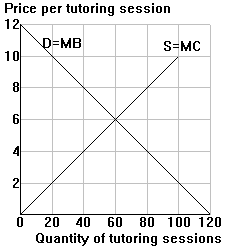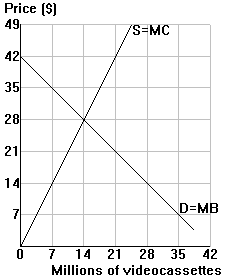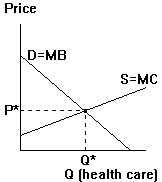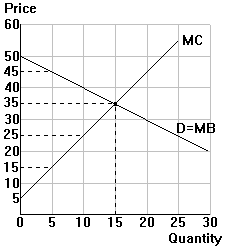| Jim Whitney |
Economics 101 |
Problem Set 3
BASIC ANALYSIS OF GOVERNMENT POLICIES
 1. Suppose that the diagram to the right depicts the student market for
tutoring services.
1. Suppose that the diagram to the right depicts the student market for
tutoring services.
a. Indicate in the diagram and compute the value
of consumer surplus and producer surplus.
b. Suppose that government concern over student
access to tutoring services results in the imposition of a price ceiling
of $3 per tutoring session. Depict the consequences of the price ceiling
in the diagram. Does a surplus or shortage result? How large?
c. Compute the new values for consumer and producer
surplus and for the welfare loss associated with the price ceiling. Indicate
these areas in the diagram.
d. Comparing your answers in parts a and c, why
do you think consumers might lobby for price ceilings despite the resulting
inefficiency?
2. The federal government imposes a price floor
in the market for dairy products. The floor is often referred to as a "support
price." For dairy products, the government buys up any surplus production
which occurs.
a. Illustrate the effects of a price floor for dairy
products in a supply and demand diagram. Indicate in your diagram the quantity
of dairy products which is bought up by the government.
b. Consider the following passage from Business
Week magazine: "Says Irvin Elkin, president of the Associated Milk Producers
Inc. 'Major cuts in [dairy] support prices run the risk of driving many
dairy farmers out of business, which would mean higher milk prices.'" What
is probably correct about Elkin's assertion? What is incorrect? Support
both answers.
 3. Suppose the diagram to the right shows the market for X-rated videocassettes.
Suppose that the government imposes a tax of $21 on each X-rated videocassette
sold.
3. Suppose the diagram to the right shows the market for X-rated videocassettes.
Suppose that the government imposes a tax of $21 on each X-rated videocassette
sold.
a. Depict in the diagram: (1) the quantity marketed
with the tax (Qt), (2) the price buyers pay with the tax (Pbt), and (3)
the price sellers receive with the tax (Pst).
b. Indicate in the diagram each of the following
consequences of the tax and calculate the numerical value for each
one: (1) the change in consumer surplus, (2) the change in producer surplus,
(3) the tax revenues collected by the government, and (4) the change in
social welfare.
 4. Suppose the diagram to the right depicts the market for health care
services (for this problem, ignore recent health reform proposals and just
consider health care to be like any ordinary product). Now suppose that
the U.S. adopts a system of subsidized national health insurance in which
health care services are financed by general tax revenue, and individual
patients are not charged for the health care services they individually
consume.
4. Suppose the diagram to the right depicts the market for health care
services (for this problem, ignore recent health reform proposals and just
consider health care to be like any ordinary product). Now suppose that
the U.S. adopts a system of subsidized national health insurance in which
health care services are financed by general tax revenue, and individual
patients are not charged for the health care services they individually
consume.
a. Indicate in the diagram: (1) the new quantity
demanded of health care (hint: what is the new price paid by individual
patients?) and (2) the price health care providers will have to receive
to induce them to supply the new quantity demanded (hint: how high is MC
at the new quantity demanded?).
b. Indicate the diagram each of the following consequences
of the health insurance program: (1) the change in consumer surplus, (2)
the change in producer surplus, and (3) the cost of the program to taxpayers.
5. Mankiw, Chapter 6, Problems and Applications
number 8, page 130.
MARKET FAILURE
6. State whether the following is true or false:Vaccinations
against contagious diseases are frequently provided to school children
at no charge because the vaccinations themselves are free. If false, then
why are they provided for free?
7. The accompanying table shows the supply and demand
schedules for pulp paper in the country of Academia:
| |
Quantity (tons/year) |
| Price per ton |
Demanded |
Supplied |
| $150 |
1,000 |
7,000 |
| 140 |
2,000 |
6,000 |
| 130 |
3,000 |
5,000 |
| 120 |
4,000 |
4,000 |
| 110 |
5,000 |
3,000 |
| 100 |
6,000 |
2,000 |
a. Plot the demand and supply curves and show the equilibrium
price and quantity.
b. Suppose that the production of pulp paper results
in external pollution costs of $20 per ton produced. In your diagram, draw
the social marginal cost (SMC) curve for pulp paper, and indicate the efficient
quantity of pulp paper production.
c. What policy would you recommend to reach the
efficient quantity of pulp paper production? Illustrate the policy in your
diagram. Under your policy, what price do buyers pay for pulp paper? What
price do sellers receive?
8. Mankiw, Chapter 10, Problems and Applications
number 5, page 217.
MARKET POWER
 9. The diagram to the right represents the situation for a monopoly firm
which is trying to decide what price to charge.
9. The diagram to the right represents the situation for a monopoly firm
which is trying to decide what price to charge.
a. Compare producer surplus at the competitive price
of $35 with producer surplus at a monopoly price of $40. How much does
the producer gain? Explain where this gain comes from.
b. How much consumer surplus do consumers lose as
a result of the monopoly price? Explain why the loss in consumer surplus
exceeds the gain in producer surplus.
c. Would the producer be even better off with a
monopoly of $45? Why or why not? Is Adam Smith correct when he says, "The
price of monopoly is upon every occasion the highest which can be got"?
Explain.
10. Evaluate the following statement: "Monopoly
is good for producers but bad for consumers. The gains for producers offset
the losses for consumers, so on balance there is no reason to think that
monopoly is bad for the economy."
11. Mankiw, Chapter 15, Problems and Applications
number 16, page 335.
12. Answer the following questions based on the
supplementary reading, "23 Colleges
in East Adjust Aid to Avert Bidding for Students" (the article,
"The Rebirth of the Ivy Cartel,"
contains an update of the situation):
a. A group of 23 select Eastern colleges have met
privately to insure that a student seeking financial aid was offered roughly
the same amount by each school in the group. What obstacles must be overcome
by any group of sellers attempt to "collude" and "fix" prices?
b. Which of the obstacles in question 1 are causing
difficulty for this specific group of sellers? Cite evidence from the article
for support.
c. Consider the last
three paragraphs of the article.
(1) Do you agree with Pat Waters from Mount Holyoke
that "the amount isn't large enough to make anyone change their mind"?
If you disagree, why? If you agree, then why do you think Mount Holyoke
would offer it?
(2) Does the financial aid officer quoted in passage
A agree with Pat Borders? Explain briefly.
INCOME DISTRIBUTION
13. Mankiw, Chapter 18, Problems and Applications
number 3, page 399.
14. Suppose you observe Worker A in Job A earning
$45,000 and Worker B in Job B earning $30,000 per year. Explain how each
of the following could help you explain the observed income differential.
In each case, assume that everything about the two jobs and workers is
similar except for the stated difference:
a. Worker A has 16 years of education, and Worker
B has 12 years of education.
b. The work hours are 2 PM to 11 PM for Job A and
8 AM to 5 PM for Job B.
c. Worker A is a man; Worker B is a woman.
 1. Suppose that the diagram to the right depicts the student market for
tutoring services.
1. Suppose that the diagram to the right depicts the student market for
tutoring services.
 3. Suppose the diagram to the right shows the market for X-rated videocassettes.
Suppose that the government imposes a tax of $21 on each X-rated videocassette
sold.
3. Suppose the diagram to the right shows the market for X-rated videocassettes.
Suppose that the government imposes a tax of $21 on each X-rated videocassette
sold.
 4. Suppose the diagram to the right depicts the market for health care
services (for this problem, ignore recent health reform proposals and just
consider health care to be like any ordinary product). Now suppose that
the U.S. adopts a system of subsidized national health insurance in which
health care services are financed by general tax revenue, and individual
patients are not charged for the health care services they individually
consume.
4. Suppose the diagram to the right depicts the market for health care
services (for this problem, ignore recent health reform proposals and just
consider health care to be like any ordinary product). Now suppose that
the U.S. adopts a system of subsidized national health insurance in which
health care services are financed by general tax revenue, and individual
patients are not charged for the health care services they individually
consume.
 9. The diagram to the right represents the situation for a monopoly firm
which is trying to decide what price to charge.
9. The diagram to the right represents the situation for a monopoly firm
which is trying to decide what price to charge.